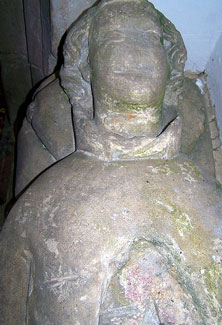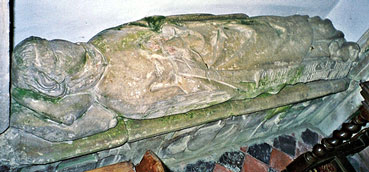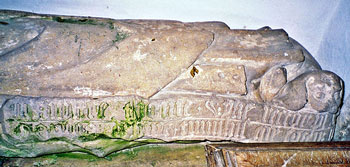| Little
Steeping St Andrew |
|
 |
Thomas of Reading, Rector (1318-1353) The inscription is in Norman French |
 |
Leasingham St Andrew |
 |
|
| Edward Trollope Bishop of Nottingham, Rector (1843-1893) | Bust of Lady |
| Linwood - St Cornelius | |

John & Alice Lyndewood (1419) with four
sons and three daughters. These two brasses were
commissioned by the second son William, Bishop of St Davids.
|

John Lyndewood (1421) wool merchant: note
the sack with merchant's mark. Eldest son of John & Alice.
|
 |
Louth - St James |
| James Fowler
JP (1828-1892) Five times mayor. Known as 'Fowler of Louth' he was an ecclesiastical architect, associated with restorations; he was diocesan surveyor 1871-1888 |
| Nocton - All Saints | |
| A tall standing
monuments in white & gray marble to Sir William Ellys
(1680) attributed to William Santon;
no figures. Other monuments are of the 19th century with work by John Bacon Jnr, Richard Westmacott & G P White. They include a monument to the First Earl of Ripon (1859) designed by Scott with a recumbent white marble effigy by Mathew Nobel 1862 (shown) |
 |
| Newton by Toft - St Michael | |
 |
 |
| Helaine
William A pair of minature stone effigies, he 29", she 24"; their names are carved on the slabs. |
|
| Norton Disney - St Peter |
 |
 |
 |
||
| Above Lady 14th century. Note her
feet resting on lions and the shields with the D-Iseni arms on the plinth. The
inscription reads: Here lies Hautacia,
daughter of William Disney, Lord of Norton.
Right:A Disney Lady c. 1300 Slender figure under an arch in the north wall with d'Isigny shields in wall behind. Very good. Far Right:A Disney (d'Isigny) c 1350. Military effigy on tomb-chest. Straight legs, mail, praying, shield carved with d'Isigny arms |
 |
 |

.
|
|
Above left:
Joan Disney mid 14th
century.
An elaborate semi-effigial slab. It features a cusped
staright-armed cross flanked by shields, above which is a canopy
with the sunk-relief bust of a lady with flowing hair, resting
her head on a pillow and wearing a tight sleeved gown, buttoned
from the wrist to the elbow, hands in prayer. Within the cusped
architectural mount of the cross are her feet, lying on a hound,
again in sunk relief. The incised Norman-French Lombardic
inscription around the slab records her being Joan, wife of Sir
William Disni and daughter of Nicholas de Lancforte. A similar
effigy to a member of the same family is at Kingerby. Above centre:William Disney (ob. 1540) and family. An unusual geneological brass of c 1580. A quadrangular plate with two panels of demi-effigies. The upper shows William facing his wife, Margaret Joiner, across a prayer desk, with behind their 5 sons and 4 daughters, their names in scrolls. Below, forward facing are Richard Disney (ob. 1578), William's heir, and his two wives, Nele Hussey and Jane Ayscough. Behind Nele are ranged 7 sons and 5 daughters, but the area behind Jane is blank, indicating that she was childless. The boys' names have been cut out but the girls' survive. This is a palimpsest brass, the reverse having been part of a Flemish incription (another portion of which is on the back of a brass at West Lavington, Wiltshire) recording the endowment of a mass in 1518 by Adrian Adrianson and Paechine van den Steyne in the church of Westmonstre in the city of Middleburgh. The brass is mounted on a hinge so that both sides can be viewed. The Netherlands were under the unpopular rule of the Catholic Spanish King, Phillip ll and opposition under the protestant William the Silent led to destruction in the Low Country churches, initially motivated by iconoclasm but later the raise money; much brass scrap was sold to London and Norwich based brass engravers. This Disney brass is illustrated in Gough Sepulchral Monuments Volume 1 Part 1 facing page cxxii. The d'Isneys are ancestors of Walt Disney Above right: Fourth Viscount St Vincent by J. S. Westmacott, 1887. Angel with a wreath hovering over a flag. Still in the Georgian tradition of the Westmacott family Also but not shown: Sir William Disney, husband of Joan above. Brass indent which shows a cross-legged knight under a canopy, with a fillet inscription round the perimeter of the slab. c 1330 |
||
|
Pinchbeck St Mary |
 |
| Margaret Carr (1603) wife of John Lambert. Painted & gilded brass. Her arms are on the left; her husband's on the right, supposedly going back to the time of William the Conqueror. The marriage arms are on her dress. |
| Rand - St Oswald |
|
Two fine medieval monuments: A coped coffin lid in Tournai marble, c. 1200 A lady of the late 13th century, shield on her middle, inspired by the Angel Choir of Lincoln Cathedral. The five other monuments are Elizabethan to Jacobean. |
| Rippingdale - St Andrew |
|
Deacon, mid 13th century, holding open book
with inscription; very rare type.
knight (late 13th century. Cross legged Another similar but defaced. Early to mid 14th century lady on tomb chest; ogee canopy above her head & similar above whole tomb. Richard de Quincey & Wives( Late 15th century) male with two ladies; effigies on tomb chest with angels holding shields in panel The Brownlow children of 1669 and earlier: an aedicule. |
|
Redbourne - St Andrew Redundant Churches Fund |
 Low tomb recess
with cusped ogee arch. Low tomb recess
with cusped ogee arch.Incised slab to Sir Gerald Sothill (1410) of foreign manufacture according to Greenhill. William Carter (1752) & Roger Carter (1774); both of c 1775 by Richard Hayward. Very fine. Charlotte Carter Thelwall (1780), also by Roger Hayward. Lady William Beauclerk (1781); Grecian. Duchess of St Albans (1837), a draped Greek altar by Chantrey. She was the window of Thomas Coutts. 9th Duke of St Albans (1851); a big relief of a mourning mother and two children by J G Lough. (shown) |
| Riby - St Edmund |
 William and Elizabeth
Tomline (1773) free standing wreathed urn in
niche; above a small tablet with woman by urn with
drapery from above. Signed: L. Tomline Delineat
(shown) William and Elizabeth
Tomline (1773) free standing wreathed urn in
niche; above a small tablet with woman by urn with
drapery from above. Signed: L. Tomline Delineat
(shown)Marmaduke Tomline (1803) Signed E Tomline delineat and P M VanGelder fecit 1806 John Parkinson (1840) white marble |
| Scawby - St Hybald | |
 |
 |
| Richard Nelthorpe (1640) & Ursula Attributed to Marshall workshop | Mjr Grosvenor Talbot Cliff (1913) Chavelier de la Legion D'Honneor. Died st Tincort, France as a result of an accident |
| Scredington - St Andrew |
 |
|
 |
 |
|
| Thomas Wyke (c 1394) priest. Note the dog at his feet, besides which is an inscription: 'Memore Thomas Wyke rector PX guadia de p me tumulus'. | ||
|
|
||||||||
| Scotton - St Genewys |
 |
|
 |
 |
|
| Above
left: Robert de Neville (?) c 1300 Above right: Lady said to be wife of the above Right: Hugh Hannesworth 15th century priest |
||
| South Cockerham - St Leonard | |
 |
Sir Adrian Scrope (1623), alabaster semi-reclining effigy. Against tomb chest kneeling daughters and sons. By Epiphanius Evesham.(shown) |
| South Kelsey - St Mary |
 Francis Ayscough |
 Richard Hansard (1410) & Joan (1397) |

 |
| Said to be Richard (1313) or Robert Hansard who fought in the Scottish Wars under Edward I |
|
|
||||||
|
|
| Spilsby - St James |
|
Series of Willoughby & Bertie
monuments in chapel: |
| Stallingborough SS Peter & Paul | ||
 |
 |
 |
|
Top right: Sir Francis Ayscough ,
bust in arched recess. This was the brother of Anne Ayscough who
tradition has it was the person who betrayed her. He expression
is said to be "cold and chilling". |
||
|
Richard Cecil (1587) & wife;
alabaster with two figures kneeling, facing across a prayer desk
with three daughters kneeling below. By Cornelius Cure. |
|
Cyril Jackson (1797) by
Westmacott. John Truman (1788) by Bingham. William Harper (1803) by Bingham Elizabeth Plumptre (1806) by William Harrison. Thomas Truman (1810) by Harrison. Mary (1814) & Henrietta (1817) Mottram John Lawson (1828) by Gilbert Martha Etough (1835) by Smith of Stamford Edward Henry (1862) & Henry Poyntz Cecil ( 1858) White marble with large frontal angle and portrait medallions below. By G M Benzoni of Rome (1864) Brownlow Cecil (1867), a Gothic tablet. Lord Thomas Cecil (1873) by Millward & Co, London. There is also a large group of mainly plain 19th century tablets. |
|
 |
| Stenigot - St Nicholas | |
 |
 |
| Two small alabasters to Francis Velles de Guevara (1592) and Sir John Guevara (1607) | |
|
|
||||||||
| Strubby St Oswald |

William Ballett (1648) & his two wives:
Joan & Susanna He died age 99 and the figures
are represented in Elizabethean clothing, showing him as a
younger man. Note the children are shown above and behind
rather than below.
|
Swineshead - St Mary | |
 |
  |
||
| Cartouche to an unknown lady | Kneeling children and babies from the monument to Sir John Lockton (1610). The only remains of this monument |
| Swinhope - St Helen |
 |
| Charlotte Mary Pye (Yerburgh) (1847) Also to her two children, both sons one of who died shortly after birth In 1827, and the other at 12 days in 1827. A daugher, also Charlotte, lived until 1869. Although he husband's name was Pye, he was the son of Reverend Marmaduke Alington but took the name Pye under the terms of the will from which he inherited the fortune of his aunt, Sarah Rowe. By T Gaffin |
|
|
Tathwell - St Vedast |
|
|
Edward Hanby (1626) and Wife standing albaster
wall monument in four tiers: at foot kneling children in relief,
then the couple kneeling and facing each other across a pryer
desk, then a kneeling son (1626) and then the
acheivements. Inscription. |
|
|
|
|||||||||
|
|||||||||||
|
|
|
| West Rasen - All Saints | |
 |
 |
| Priest 14th century | |
















